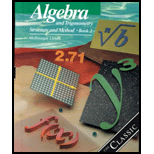
Concept explainers
a.
To choose: Two variables that represent the number asked in the given sentence
a.
Answer to Problem 8P
Final Answer: The number of nickels = 2x, the number pennies= x
The number of Dimes = y +4, the number of quarters= y
Explanation of Solution
Given Information: It is given that a bag contains twice as many pennies as nickels and four more dimes than quarters. We need to choose two variables to represent these numbers
Calculation: Since it is given that the bag contains twice as many pennies as nickels
Let the number of nickels = x
Then the number of pennies = 2x
And as it is given that the bag contains four more dimes than quarters.
Let the number of quarters = y
Then the number of dimes= y +4
b.
To write: An open sentence relating the variables x and y in the given condition
b.
Answer to Problem 8P
Final Answer:
Explanation of Solution
Given Information: It is given that the total value of all pennies, nickels, dimes and quarters taken together is $2.01
Formula Used: 1 nickel = 5 cents, 1 penny = 1 cent, 1dime = 10 cents, 1 quarter = 25 cents,
1 dollar = 100 cents.
Calculation: Since we know that the number of nickels = x
Number of pennies = 2x, number of quarters = y, number of dimes = y+ 4
Since all coins taken together gives the value of $2.01 that is, 201 cents
Therefore,
According to the question,
Or
Or
c.
To find: All the possibilities for the number of each coin satisfying the given condition
c.
Answer to Problem 8P
Final answer: All the possible number of nickels are {3,8,13,18,23}
The possible number of pennies are {6,16,26,36,46}
The possible number of quarters are {0,1,2,3,4}
The possible number of dimes are {4,5,6,7,8}
Explanation of Solution
Given Information: It is given that we have x nickels, 2x pennies, y quarters, ( y + 4) dimes
And the condition that we have obtained is
Calculation: Since we have obtained
Or
From (1), we can say
So, x can take the value of 3, 8, 13, 18, 23
When x = 3, y = 4 x = 13, y = 2
x = 8, y = 3 x = 18, y = 1
x = 23, y = 0
Now since the number of nickels = x
So possible number of nickels are {3,8,13,18,23}
Since the number of pennies = 2x
So possible number of pennies are {6,16,26,36,46}
Since the number of quarters = y
So possible number of quarters are {0,1,2,3,4}
Since the number of dimes = y + 4
So possible number of dimes are {4,5,6,7,8}
Chapter 3 Solutions
Algebra and Trigonometry: Structure and Method, Book 2
Additional Math Textbook Solutions
Introductory Statistics
Elementary Statistics (13th Edition)
Thinking Mathematically (6th Edition)
Elementary Statistics
Elementary Statistics: Picturing the World (7th Edition)
- 13) Let U = {j, k, l, m, n, o, p} be the universal set. Let V = {m, o,p), W = {l,o, k}, and X = {j,k). List the elements of the following sets and the cardinal number of each set. a) W° and n(W) b) (VUW) and n((V U W)') c) VUWUX and n(V U W UX) d) vnWnX and n(V WnX)arrow_forward9) Use the Venn Diagram given below to determine the number elements in each of the following sets. a) n(A). b) n(A° UBC). U B oh a k gy ท W z r e t ་ Carrow_forward10) Find n(K) given that n(T) = 7,n(KT) = 5,n(KUT) = 13.arrow_forward
- 7) Use the Venn Diagram below to determine the sets A, B, and U. A = B = U = Blue Orange white Yellow Black Pink Purple green Grey brown Uarrow_forward8) Use the Venn diagram provided to shade An Bº. A B U Darrow_forward5) Describe the difference between disjoint sets and overlapping sets.arrow_forward
- 12) Suppose U = {a,b,c,d,e) and A = {a, b, c, e) and B = (c,d,e). Determine (An B).arrow_forward1) Use the roster method to list the elements of the set consisting of: a) All positive multiples of 3 that are less than 20. b) Nothing (An empty set).arrow_forward2) Let M = {all postive integers), N = {0,1,2,3... 100), 0= {100,200,300,400,500). Determine if the following statements are true or false and explain your reasoning. a) NCM b) 0 C M c) O and N have at least one element in common d) O≤ N e) o≤o 1arrow_forward
- 4) Which of the following universal sets has W = {12,79, 44, 18) as a subset? Choose one. a) T = {12,9,76,333, 44, 99, 1000, 2} b) V = {44,76, 12, 99, 18,900,79,2} c) Y = {76,90, 800, 44, 99, 55, 22} d) x = {79,66,71, 4, 18, 22,99,2}arrow_forward3) What is the universal set that contains all possible integers from 1 to 8 inclusive? Choose one. a) A = {1, 1.5, 2, 2.5, 3, 3.5, 4, 4.5, 5, 5.5, 6, 6.5, 7, 7.5, 8} b) B={-1,0,1,2,3,4,5,6,7,8} c) C={1,2,3,4,5,6,7,8} d) D = {0,1,2,3,4,5,6,7,8}arrow_forward5) 8.4 6.3 ?arrow_forward
 Algebra and Trigonometry (6th Edition)AlgebraISBN:9780134463216Author:Robert F. BlitzerPublisher:PEARSON
Algebra and Trigonometry (6th Edition)AlgebraISBN:9780134463216Author:Robert F. BlitzerPublisher:PEARSON Contemporary Abstract AlgebraAlgebraISBN:9781305657960Author:Joseph GallianPublisher:Cengage Learning
Contemporary Abstract AlgebraAlgebraISBN:9781305657960Author:Joseph GallianPublisher:Cengage Learning Linear Algebra: A Modern IntroductionAlgebraISBN:9781285463247Author:David PoolePublisher:Cengage Learning
Linear Algebra: A Modern IntroductionAlgebraISBN:9781285463247Author:David PoolePublisher:Cengage Learning Algebra And Trigonometry (11th Edition)AlgebraISBN:9780135163078Author:Michael SullivanPublisher:PEARSON
Algebra And Trigonometry (11th Edition)AlgebraISBN:9780135163078Author:Michael SullivanPublisher:PEARSON Introduction to Linear Algebra, Fifth EditionAlgebraISBN:9780980232776Author:Gilbert StrangPublisher:Wellesley-Cambridge Press
Introduction to Linear Algebra, Fifth EditionAlgebraISBN:9780980232776Author:Gilbert StrangPublisher:Wellesley-Cambridge Press College Algebra (Collegiate Math)AlgebraISBN:9780077836344Author:Julie Miller, Donna GerkenPublisher:McGraw-Hill Education
College Algebra (Collegiate Math)AlgebraISBN:9780077836344Author:Julie Miller, Donna GerkenPublisher:McGraw-Hill Education





